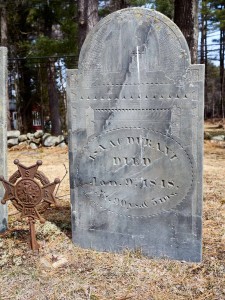Mapping Westford’s Veterans and Casualties
The town of Westford has a dedicated group of local historians and reenactors as well as the Westford Museum.
One of the latest local-history projects from Westford, created primarily by Judy Cataldo, is this online map of Revolutionary War veterans and civilian casualties in Westlawn Cemetery.
Each gravestone is pictured and accompanied by a profile of the person it commemorates. For instance:
One of the latest local-history projects from Westford, created primarily by Judy Cataldo, is this online map of Revolutionary War veterans and civilian casualties in Westlawn Cemetery.
Each gravestone is pictured and accompanied by a profile of the person it commemorates. For instance:
Isaac Durant is the son of Henry and Susanna, born in Littleton on September 16, 1757. On the morning of April 19, 1775, he was living in Lexington and later testified, "that about 5:00 hearing our drum beat, we proceeded towards the parade, and soon found that large bodies of troops were marching towards us." The next month he enlisted in the army at Cambridge as a drummer and served 91 days. He continued to serve as a drummer at other times in the war, one month in 1777, 6 months in 1778, 9 months in 1779 and at the end of the war in 1781. On returning home he married Helena Wendell from Salem in 1784 and they had 9 children. He eventually moved to Westford and lived in a home on the road to the village center. Capt. David Prescott Lawrence a longtime resident of Westford stated that he remembers Isaac Durant a revolutionary soldier, who was blind and was guided about the village by a little grandson. He died in Natick on January 9, 1848 at the age of 90.Another topic that Judy Cataldo has researched over many years is the epidemic of “camp fever” that affected both soldiers and civilians in New England during the siege of Boston. The intersection of that project and this appears in the entry for the gravestone of the daughters of militia colonel John Robinson:
In the late summer and early fall of 1775, the civilians of Massachusetts towns were besieged by an epidemic of the Bloody Flux or Camp Fever, a type of dysentery that can be deadly to children. The disease was brought into the towns by soldiers returning from their service in the camps around Boston. Col. John Robinson and his wife Huldah lost 3 of their daughters within 10 days. Betty who was born 1770 and Sarah born May 3, 1772 both passed on August 30, 1775 and Mehetebel born August 9, 1767 died on September 7 1775.It would be nice to see more local projects like this during the Sestercentennial. And to see them preserved in forms that will survive the evolution of the web.


1 comment:
As a Find-a-Grave volunteer I noted the increased death rate amongst children in Groton in August and September of 1775. Some 2 dozen in number, in a town where 4-5 people died yearly.
Post a Comment